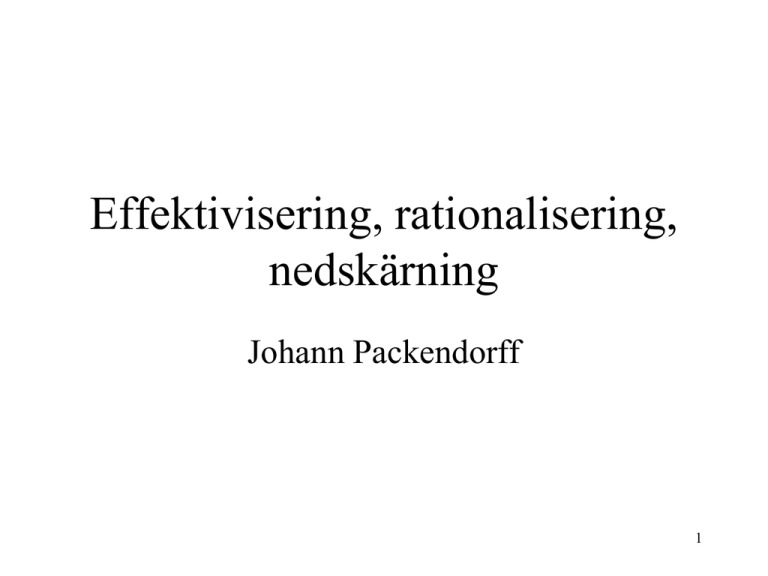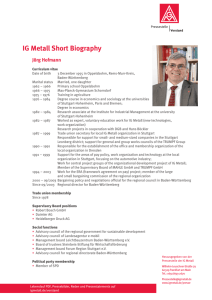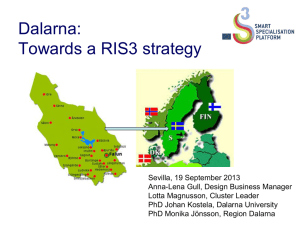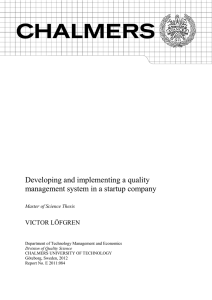improvement
advertisement

Effektivisering, rationalisering, nedskärning Johann Packendorff 1 Delivery performance is 87% Is this good, bad, or indifferent ? Absolute performance = 100% 100 Customer expectation = 98% Target performance = 95% Percentage of deliveries on-time 90 X X 80 70 X 60 X X Competitor performance = 81% X Performance against customer expectations is POOR Historical performance is GOOD Performance against target is POOR Performance against competitors is GOOD Absolute performance is POOR 50 Now 2 Cumulative improvement Continuous and breakthrough improvement Breakthrough improvement Continuous improvement Time 3 Performance Intended performance improvement with breakthrough improvement Breakthrough improvements Time 4 Performance Actual performance improvement with breakthrough improvement Actual improvement Time 5 Performance Performance improvement with continuous improvement Standardize and maintain Improvement “Continuous” improvement Time 6 Define Plan Do Measure Control Act Check (a) Improve Analyze (b) (a) The plan-do-check-act, or “Deming” improvement cycle, and (b) The define-measure-analyze-improve-control, or DMAIC six sigma improvement cycle 7 Performance PDCA Cycle repeated to create continuous improvement Plan Act Do Check “Continuous” improvement Time 8 Common techniques for process improvement Input/output analysis Flow charts Scatter diagrams x Input Out put x x Cause-effect diagrams Pareto diagrams x x x x x x x x Why-why analysis Why? Why? Why? 9 ”Japanska sjön” som förändringsfilosofi - Höj ambitionsnivån i ett avseende, och låt konsekvenserna av detta slå igenom fullt ut! 10 Processförbättring innebär organisationsförändring! 11 Organizational Change • Managing today would be more accurately described as long periods of ongoing change, interrupted occasionally by short periods of stability. 12 Why People Resist Change • Habits – We are creatures of habit. • Fear of the unknown. • Security – The higher the need for security, the stronger the resistance. • Economic factors. • Selective information processing – We all have our own ideas of what is right. 13 Why Do Organizations Resist Change? • • • • • Group inertia – Peer pressure, group norms. Security. Threat to established power relationships. Threat to established resource allocations. Limited focus of change – Change affects others in the organization. • Poor communication. • Threat to expertise. 14 Techniques for Change Implementation • • • • • • • Establish a sense of urgency for change. Establish a coalition to guide the change. Create a vision and strategy for change. Find an idea that fits the need. Develop plans to overcome resistance. Create change teams. Foster idea champions. 15 What Can Change Agents Change? • Structure – Change agents can alter one or more of the key elements in an organization’s design. • Technology – Competitive factors or innovations within an organization often require change agents to introduce new equipment, tools, or methods. • People – Change agents help individuals and groups within the organization work more effectively together. • Physical Settings – Change agents can affect their environment. 16 Organizational Change • Resistance is not all bad. Resistance: – forces management to check and recheck the proposals. – helps identify specific problem areas where change is likely to cause difficulty. – gives management information about the intensity of employee emotions on the issues. – provides a means of release of emotions. This causes employees to think and talk more about the changes. 17 Organisationens storlek - en fråga om förändringsledning! 18 Change through re-sizing the organization • • • • • • • • • Downsizing Compressing Consolidating Contracting Demassing Dismantling Downshifting Rationalizing Reallocating • • • • • • • • • • Reassigning Rebalancing Redesigning Resizing Retrenching Redeploying Rightsizing Streamlining Slimming down Leading up Background and Practical Importance • Assumptions: 1980s – Bigger is better – Growth in employee base is natural and desirable – Slack resources allowed adaptability and flexibility – Consistency is a hallmark of effectiveness Background and Practical Importance • Events: 1980s & 1990s – – – – Recession in early 1980s Recession in early 1990s Decline in our global competitiveness US business press said “American businesses are fat, dumb, happy & starting to lose!” – Virtually all major firms downsized between 1985 and 1990 – Assumptions of early 1980s challenged. The new model: “Lean is mean!” Background and Practical Importance • 1990s and 2000s – The “recession” of 2000-2003 – Tendency to lay off only blue-collar workers challenged; white-collar layoffs multiply – Research shows most layoffs damage productivity and morale – Crisis precipitated by the burst of the IT bubble (March 2000) and terrorist action (September 2001) • Leads to “Organizations must downsize to survive the crisis!” • Massive, concurrent layoffs implemented quickly Today (2010) • Major financial crisis preceded by forceful growth period • Companies do not want to repeat the mistakes from 1998-2001 • Productivity improvements by process innovation rather than capacity improvements by expanding org size • Outsourcing debate 23 How Managers Conceptualize Downsizing • Reinforcement – Overall objective is to perpetuate the current mission, strategy, and systems with a focus on adapting to current circumstances • Reorientation – Overall objective is to change the current mission, strategy, and systems with a focus on discontinuing previous activities How Downsizing Is Implemented: Three Types of Strategies • Workforce reduction strategy – Most common approach • Organization redesign strategy – About 27% of cases • Systemic strategy – About 21% of cases Workforce Reduction Strategy • • • • • Focus on workers Eliminates people Quick implementation Goal: Short-term payoff Inhibits: Long-term adaptability Organization Redesign Strategy • • • • • Focus on jobs and units Eliminates work Moderate pace of implementation Goal: Moderate-term payoff Inhibits: Quick payback Systemic Strategy • • • • • Focus on culture Eliminates status quo processes Extended implementation process Goal: Long-term payoff Inhibits: Short-term cost savings Common Impacts of Downsizing • For the “across the board, grenade approach” – – – – Organizational dysfunction Ineffectiveness Lack of improvement Lack of development of quality culture • For the systemic analysis approach – – – – Improvement in performance Improved involvement and communication Development of quality culture Organizational survival Best Practices in Downsizing • Implemented top down and initiated from bottom up (i.e., let the right people pick which jobs are eliminated) • Across-the-board downsizing sent message to stakeholders, but selective downsizing enhanced effectiveness • Successful downsizing involved managing the transition for those who lost jobs and managing the transition for survivors Cont. Best Practices in Downsizing (Cont.) • Focused on internal efficiency barriers and relationships outside the organization • Focused on creating small, semiautonomous units within large integrated organizations • Downsizing was “means to end,” not just end in itself • Other? Sammanfattning • Produktionsledning innebär en ständig aktiv processförbättring, snarare än stora reaktiva kliv då och då • Produktionsledningen måste utsätta produktionssystemet för förändringstryck på egen hand • Förändringsmotstånd är naturligt, och måste användas på ett konstruktivt sätt • Hantering av organisatorisk storlek har blivit allt viktigare • Alla förändringar av organisatorisk storlek måste dock hanteras som långsiktiga organisationsförändringar, förutsatt att organisationen inte står inför sin undergång 32



